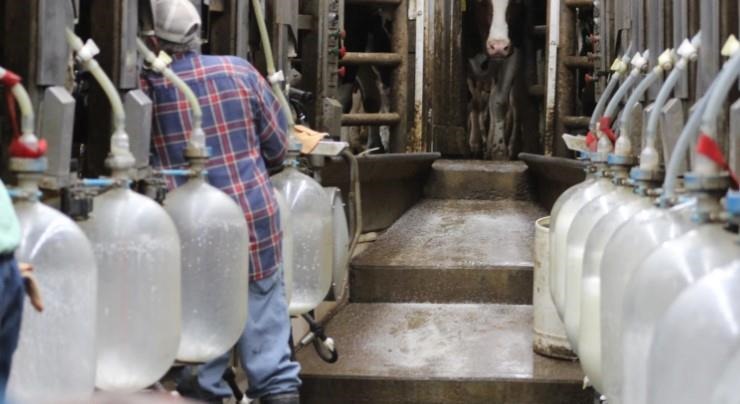This year’s long winter and late spring have eaten into livestock hay supplies.
“North Dakota ranchers will need another good year of hay production to restore what was fed during this winter and build a cushion for future hay demands created by environmental conditions,” says James Rogers, North Dakota State University Extension forage specialist.

A good annual forage production strategy helps meet nutritional needs of livestock.
NDSU Extension specialists recommend several annual forage crops that will produce a quality hay product that can meet nutritional needs of many classes of livestock.
Early spring planting (April-May)
In early spring, recommended cool-season cereal forages include oats, triticale and barley.
“These crops can produce good yields with excellent nutrient value when harvested from late boot to soft dough stages of development,” says Rogers. “Oat and triticale yields can be slightly higher than barley or wheat. These crops can also be planted into late June and can achieve good yields if rainfall is adequate.”
Seed costs and availability may dictate selection more than agronomic characteristics of the cool-season cereals. Cool-season cereals will take 60 to 80 days after establishment to reach a harvest point. These crops can be planted as a monoculture or blended with a legume crop such as forage pea.
“If planted as a monoculture, take a soil test prior to establishment to measure residual soil nitrate availability and adjust applications rates,” advises Rogers. “These cool-season cereal crops are all potential nitrate accumulators, and nitrogen application should be kept to 25 pounds nitrogen per acre for each ton of anticipated dry matter production.”
In a research study at the NDSU North Central Research Extension Center (NCREC) in Minot, nitrogen response for forage oats peaked at 50 pounds nitrogen per acre.
Planting a cool-season cereal and legume blend can eliminate the need for nitrogen fertilizer. Many commercial seed companies offer a 60% forage pea, 40% forage cereal blend that is ready to plant. These blends should be harvested based on maturity of the cool-season cereal.
Another option is to blend with a warm-season annual grass, such as foxtail millet or sorghum-sudan, which can produce two harvests from a single planting. At the NCREC, a blend of 25% forage oats and 75% sorghum-sudan had higher total yield from two harvests compared to a single harvest of forage oats and was similar in yield to two harvests of a sorghum-sudan monoculture.
Early summer planting
As the season moves into late spring and early summer, production potential shifts to the warm-season grasses. Annual millets (foxtail, proso, pearl and Japanese) are the most popular of the millets used for hay crops in the northern Plains. The foxtail millets offer good production, nutrient content and drought tolerance and will mature at 55 to 70 days, depending on variety. They can be planted as a monoculture or in combination with a legume or other warm season annual grasses. Regrowth potential of foxtail millet is little to none when harvested closely for hay.
Pearl millet has higher yield potential than the foxtail millets and has good regrowth potential following harvest. Pearl millet works well on lighter soils types and can be used for haying or grazing. Pearl millet does not respond well to alkaline soils. Brown mid-rib (BMR) and dwarf types are available in some pearl millet varieties. The millets can also be nitrate accumulators but tend to accumulate at lower levels than cool-season cereals. Unlike sorghums, millets do not accumulate prussic acid.
“Pearl millet is a high water use grass that also requires heat to fully be productive,” says Kevin Sedivec, NDSU Extension rangeland management specialist. “If conditions are dry and the forecast is for droughty conditions, pearl millet would not be recommended.”
According to Rogers, the crop with the highest production potential is the sorghums: forage sorghum, sudangrass and sorghum-sudangrass hybrids. This group establishes best when soil temperatures are at 60 degrees Fahrenheit and rising. Within this group, many combinations of production traits are offered, such as BMR with lower fiber and higher digestibility, dwarf types, male sterile, dry stalk, maturity, and others. They can be planted as a monoculture or combinations of legumes, millets or other crops.
As with the other crops listed here, sorghums can be nitrate accumulators. They also can develop prussic acid. Piper sudangrass has the lowest potential for prussic acid development of the sorghums. New sorghum types are being developed that contain no dhurrin, which is a precursor to prussic acid development and will be a welcome addition to the market. Harvesting forage sorghum and sorghum-sudangrass hybrids contain a large stem and can be difficult to achieve sufficient dryness to harvest for good quality, dry hay. Varieties with the dry stem trait can aid in dry down time.
These forages are not restricted to use as a hay crop. All have the potential to be grazed or made into a silage. For annual forages with good regrowth potential, such as the sorghums and pearl millet, take advantage of the flexibility the crop offers and consider haying the first cutting and grazing the second.
“Think in terms of increasing the diversity of mixtures, which can often extend seasonal distribution of forage, lower production risk and increase forage nutrient content,” says Miranda Meehan, NDSU Extension livestock environmental stewardship specialist. “Be aware of any chemical applications that might have been made to the planting area prior to establishment. Some residual soil chemical activity may interfere with seed germination. Also consider seed costs and availability. Pick the forage that works best for you in your growing season of opportunity.”
Source : ndsu.edu